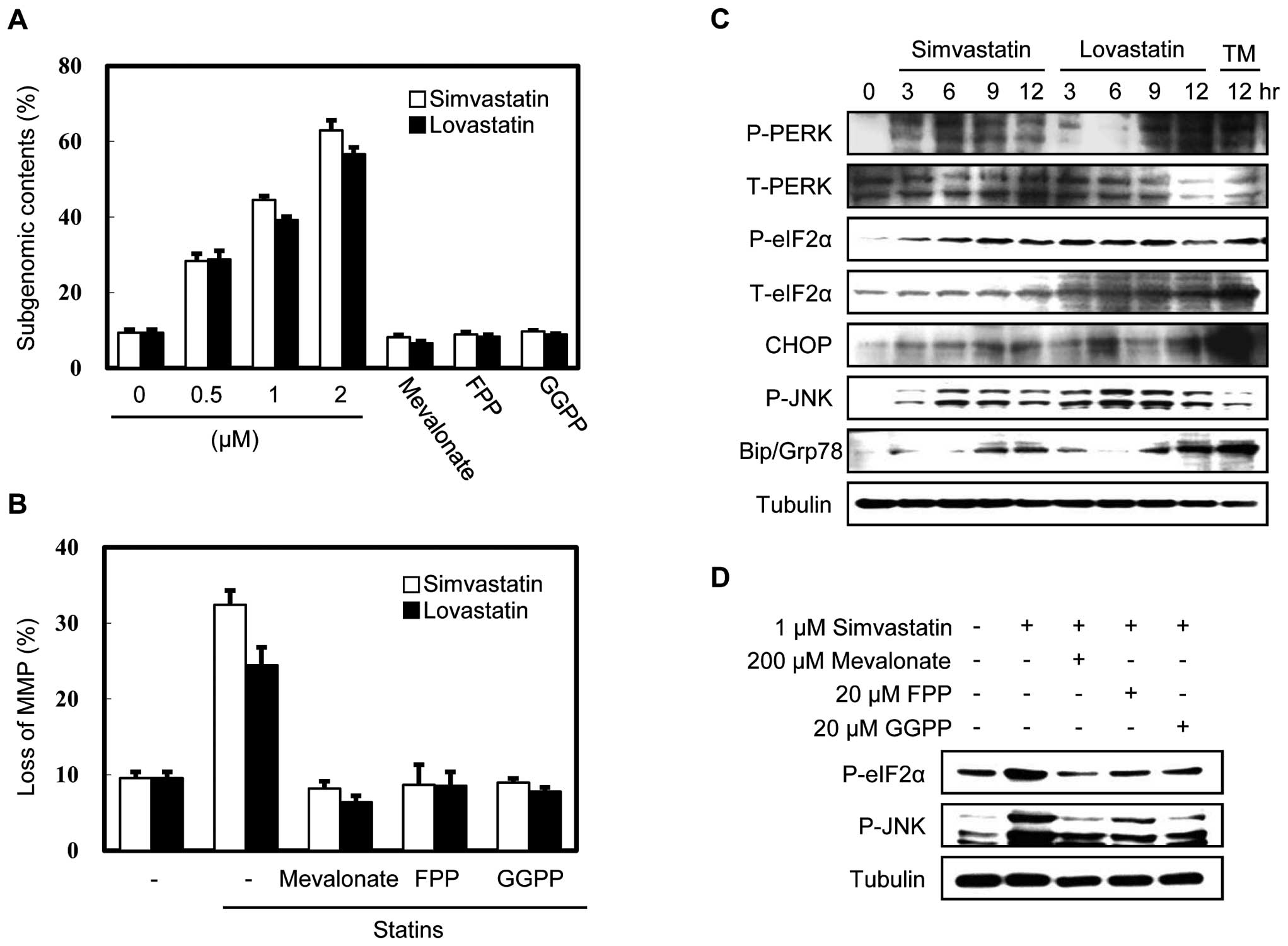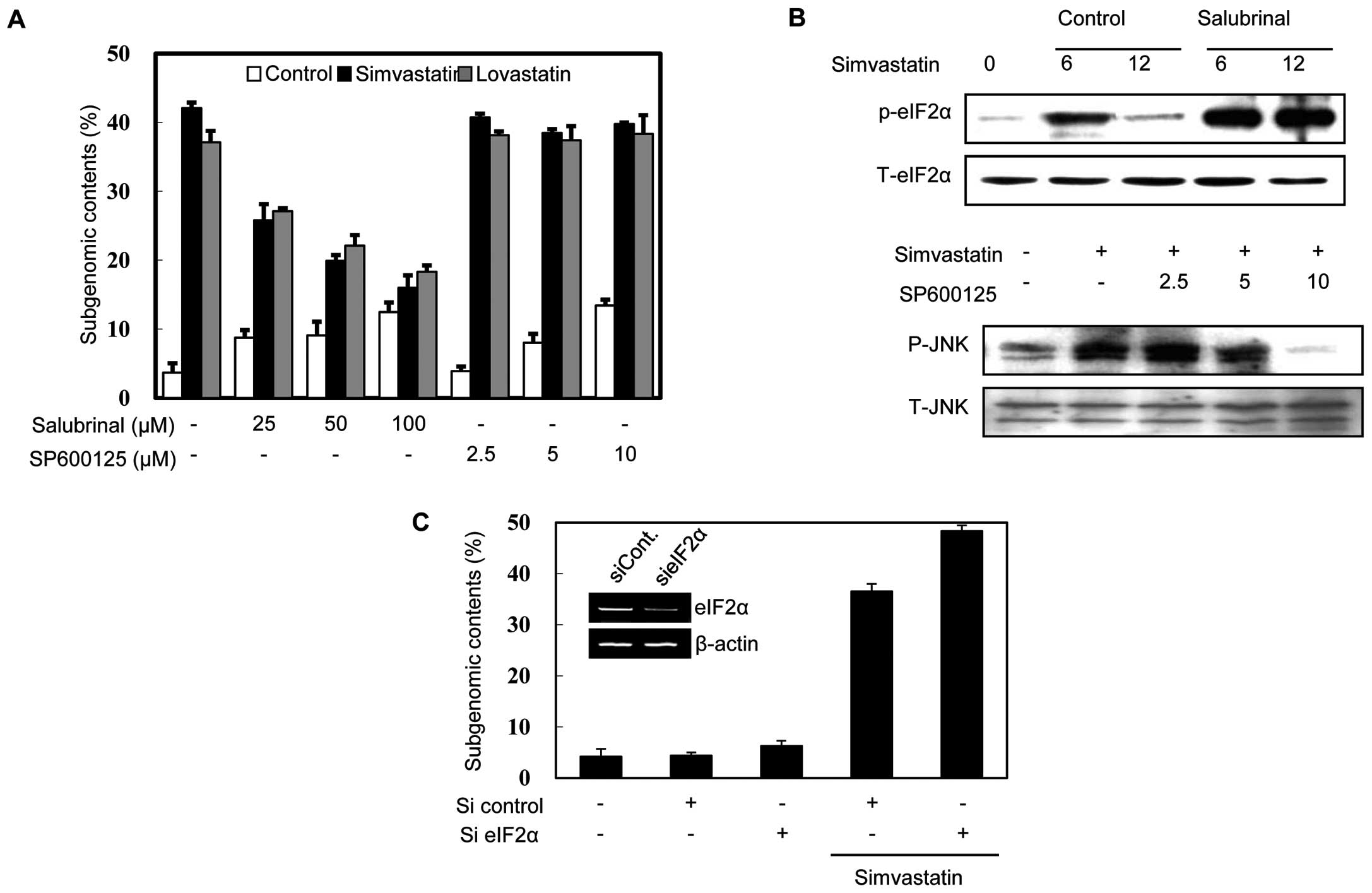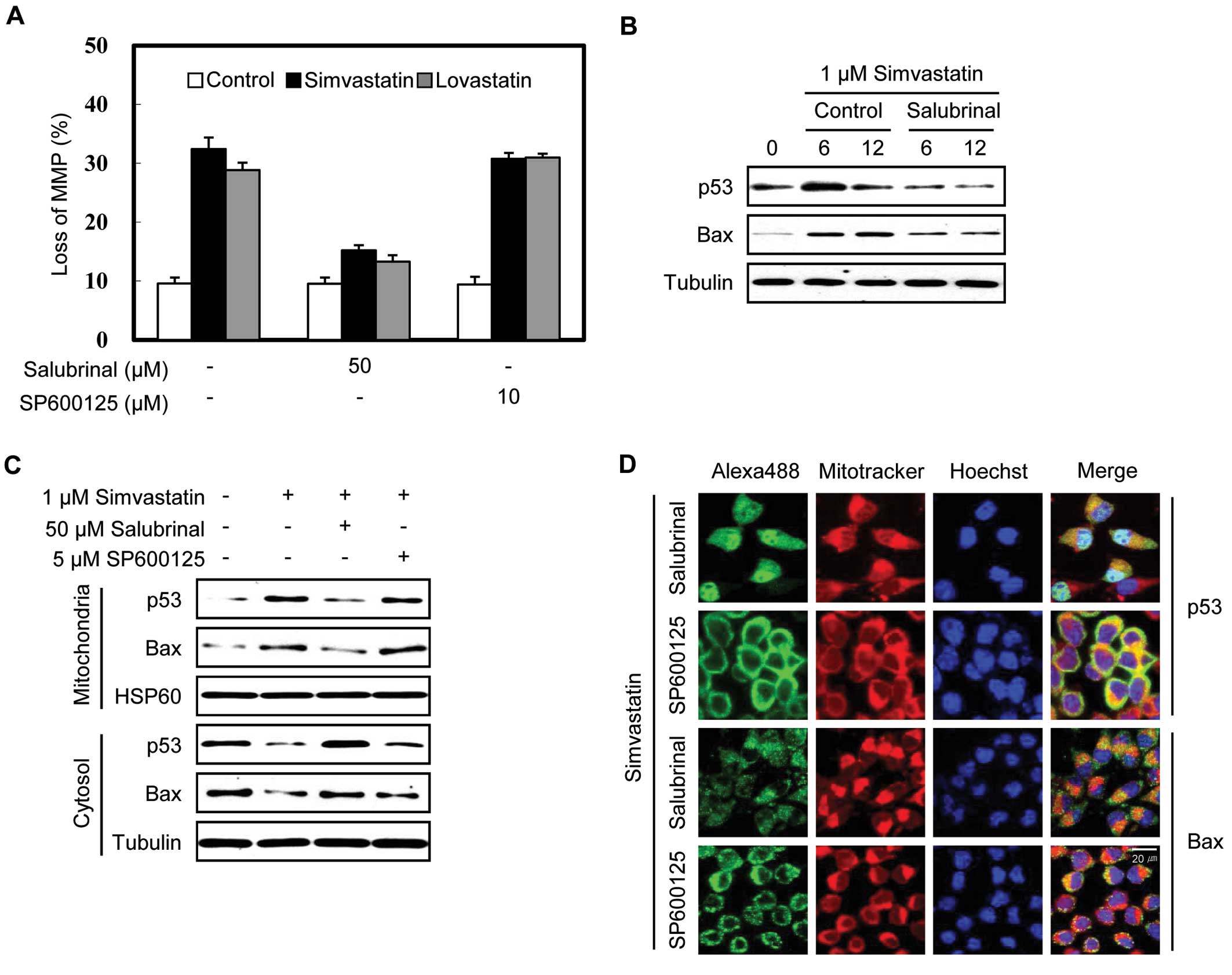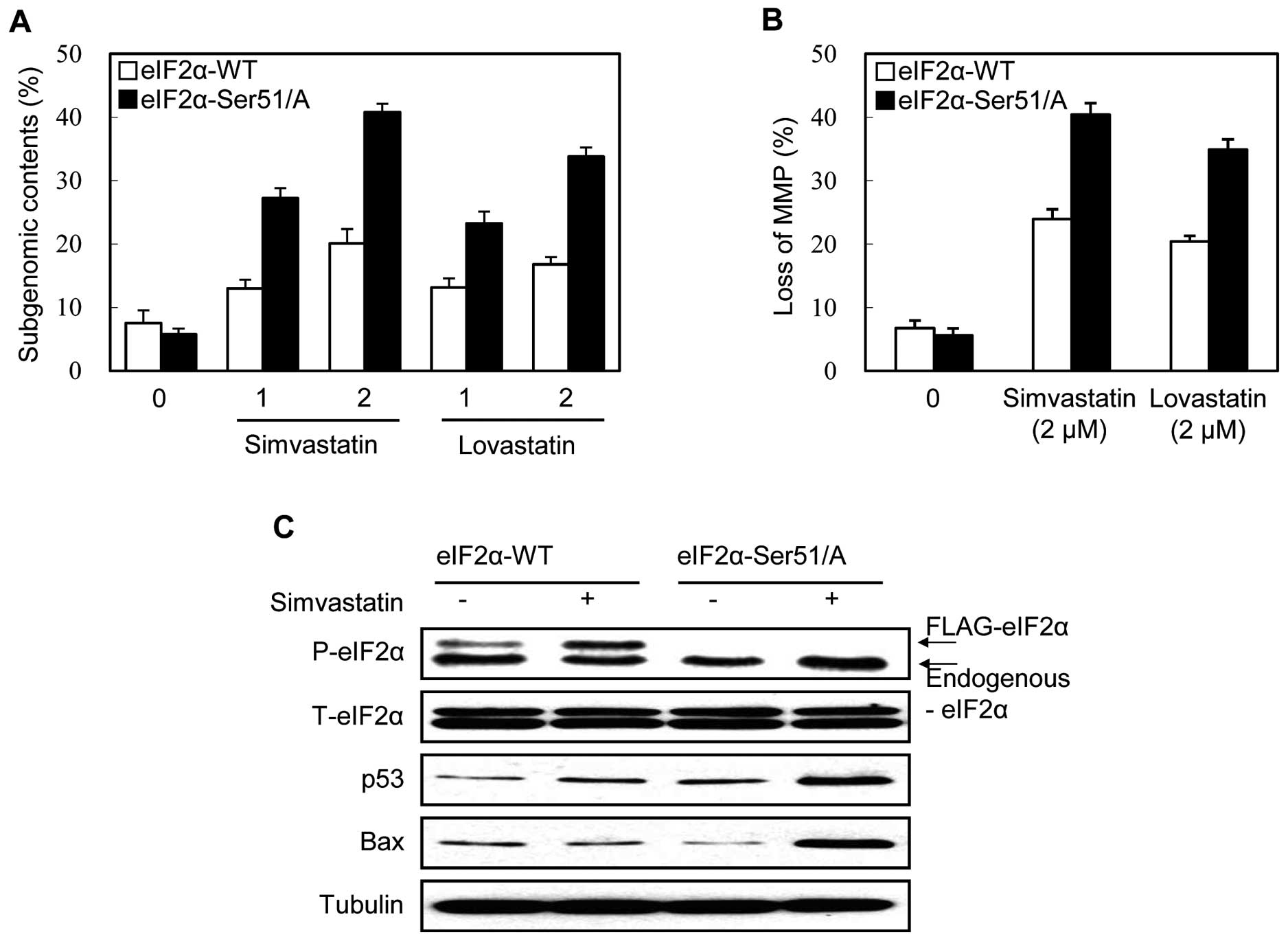|
1
|
Demierre MF, Higgins PD, Gruber SB, Hawk E
and Lippman SM: Statins and cancer prevention. Nat Rev Cancer.
5:930–942. 2005. View
Article : Google Scholar : PubMed/NCBI
|
|
2
|
Harding HP, Zhang Y and Ron D: Protein
translation and folding are coupled by an
endoplasmic-reticulum-resident kinase. Nature. 397:271–274. 1999.
View Article : Google Scholar : PubMed/NCBI
|
|
3
|
Hampton RY: ER-associated degradation in
protein quality control and cellular regulation. Curr Opin Cell
Biol. 14:476–482. 2002. View Article : Google Scholar : PubMed/NCBI
|
|
4
|
Holcik M and Sonenberg N: Translational
control in stress and apoptosis. Nat Rev Mol Cell Biol. 6:318–327.
2005. View
Article : Google Scholar : PubMed/NCBI
|
|
5
|
Chen JC, Wu ML, Huang KC and Lin WW:
HMG-CoA reductase inhibitors activate the unfolded protein response
and induce cytoprotective GRP78 expression. Cardiovasc Res.
80:138–150. 2008. View Article : Google Scholar : PubMed/NCBI
|
|
6
|
Niknejad N, Morley M and Dimitroulakos J:
Activation of the integrated stress response regulates
lovastatin-induced apoptosis. J Biol Chem. 282:29748–29756. 2007.
View Article : Google Scholar : PubMed/NCBI
|
|
7
|
Li J, Lee B and Lee AS: Endoplasmic
reticulum stress-induced apoptosis: multiple pathways and
activation of p53-up-regulated modulator of apoptosis (PUMA) and
NOXA by p53. J Biol Chem. 281:7260–7270. 2006. View Article : Google Scholar : PubMed/NCBI
|
|
8
|
Vaseva AV and Moll UM: The mitochondrial
p53 pathway. Biochim Biophys Acta. 1787:414–420. 2009. View Article : Google Scholar : PubMed/NCBI
|
|
9
|
Lee SK, Kim YC, Song SB and Kim YS:
Stabilization and translocation of p53 to mitochondria is linked to
Bax translocation to mitochondria in simvastatin-induced apoptosis.
Biochem Biophys Res Commun. 391:1592–1597. 2010. View Article : Google Scholar : PubMed/NCBI
|
|
10
|
Fritsch RM, Schneider G, Saur D, Scheibel
M and Schmid RM: Translational repression of MCL-1 couples
stress-induced eIF2 alpha phosphorylation to mitochondrial
apoptosis initiation. J Biol Chem. 282:22551–22562. 2007.
View Article : Google Scholar
|
|
11
|
Vousden KH and Lu X: Live or let die: the
cell’s response to p53. Nat Rev Cancer. 2:594–604. 2002.
|
|
12
|
Chipuk JE and Green DR: Dissecting
p53-dependent apoptosis. Cell Death Differ. 13:994–1002. 2006.
View Article : Google Scholar : PubMed/NCBI
|
|
13
|
Holstein SA and Hohl RJ: Isoprenoid
biosynthetic pathway inhibition disrupts monoclonal protein
secretion and induces the unfolded protein response pathway in
multiple myeloma cells. Leuk Res. 35:551–559. 2011. View Article : Google Scholar
|
|
14
|
Urban P, Pavliková M, Sivonová M, et al:
Molecular analysis of endoplasmic reticulum stress response after
global forebrain ischemia/reperfusion in rats: effect of
neuroprotectant simvastatin. Cell Mol Neurobiol. 29:181–192. 2009.
View Article : Google Scholar
|
|
15
|
Breder I, Coope A, Arruda AP, et al:
Reduction of endoplasmic reticulum stress - a novel mechanism of
action of statins in the protection against atherosclerosis.
Atherosclerosis. 212:30–31. 2010. View Article : Google Scholar : PubMed/NCBI
|
|
16
|
Sassano A, Katsoulidis E, Antico G, et al:
Suppressive effects of statins on acute promyelocytic leukemia
cells. Cancer Res. 67:4524–4532. 2007. View Article : Google Scholar : PubMed/NCBI
|
|
17
|
Koyuturk M, Ersoz M and Altiok N:
Simvastatin induces apoptosis in human breast cancer cells: p53 and
estrogen receptor independent pathway requiring signalling through
JNK. Cancer Lett. 250:220–228. 2007. View Article : Google Scholar
|
|
18
|
Campbell MJ, Esserman LJ, Zhou Y, et al:
Breast cancer growth prevention by statins. Cancer Res.
66:8707–8714. 2006. View Article : Google Scholar : PubMed/NCBI
|
|
19
|
Wu J, Wong WW, Khosravi F, Minden MD and
Penn LZ: Blocking the Raf/MEK/ERK pathway sensitizes acute
myelogenous leukemia cells to lovastatin-induced apoptosis. Cancer
Res. 64:6461–6468. 2004. View Article : Google Scholar : PubMed/NCBI
|
|
20
|
Scheuner D, Song B, McEwen E, et al:
Translational control is required for the unfolded protein response
and in vivo glucose homeostasis. Mol Cell. 7:1165–1176. 2001.
View Article : Google Scholar : PubMed/NCBI
|
|
21
|
Muaddi H, Majumder M, Peidis P, et al:
Phosphorylation of eIF2α at serine 51 is an important determinant
of cell survival and adaptation to glucose deficiency. Mol Biol
Cell. 21:3220–3231. 2010.
|
|
22
|
Boyce M, Bryant KF, Jousse C, et al: A
selective inhibitor of eIF2alpha dephosphorylation protects cells
from ER stress. Science. 307:935–939. 2005. View Article : Google Scholar : PubMed/NCBI
|
|
23
|
Thakor N and Holcik M: IRES-mediated
translation of cellular messenger RNA operates in eIF2α-independent
manner during stress. Nucleic Acids Res. 40:541–552.
2011.PubMed/NCBI
|
|
24
|
Ron D and Walter P: Signal integration in
the endoplasmic reticulum unfolded protein response. Nat Rev Mol
Cell Biol. 8:519–529. 2007. View
Article : Google Scholar : PubMed/NCBI
|
|
25
|
Cai Q and Brooks HL: Phosphorylation of
eIF2α via the general control kinase, GCN2, modulates the ability
of renal medullary cells to survive high urea stress. Am J Physiol
Renal Physiol. 301:F1202–F1207. 2011.
|
|
26
|
Jiang HY and Wek RC: Phosphorylation of
the alpha-subunit of the eukaryotic initiation factor-2 (eIF2alpha)
reduces protein synthesis and enhances apoptosis in response to
proteasome inhibition. J Biol Chem. 280:14189–14202. 2005.
View Article : Google Scholar
|
|
27
|
Schewe DM and Aguirre-Ghiso JA: Inhibition
of eIF2alpha dephosphorylation maximizes bortezomib efficiency and
eliminates quiescent multiple myeloma cells surviving proteasome
inhibitor therapy. Cancer Res. 69:1545–1552. 2009. View Article : Google Scholar
|
|
28
|
Liu Y, László C, Liu W, Chen X, Evans SC
and Wu S: Regulation of G(1) arrest and apoptosis in hypoxia by
PERK and GCN2-mediated eIF2alpha phosphorylation. Neoplasia.
12:61–68. 2010.PubMed/NCBI
|
|
29
|
Sayan BS, Sayan AE, Knight RA, Melino G
and Cohen GM: p53 is cleaved by caspases generating fragments
localizing to mitochondria. J Biol Chem. 281:13566–13573. 2006.
View Article : Google Scholar : PubMed/NCBI
|


















